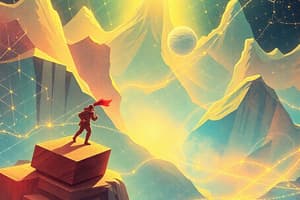Podcast
Questions and Answers
What is the main focus of macroeconomics?
What is the main focus of macroeconomics?
Examining the behavior and performance of entire economies
Define Gross Domestic Product (GDP).
Define Gross Domestic Product (GDP).
Total monetary value of all final goods and services produced within a country's borders in a specific time period
What does a rising GDP indicate?
What does a rising GDP indicate?
Economic expansion
What does GDP not account for?
What does GDP not account for?
What is unemployment?
What is unemployment?
Why is unemployment a significant concern for policymakers?
Why is unemployment a significant concern for policymakers?
What does a high unemployment rate often signal in an economy?
What does a high unemployment rate often signal in an economy?
Why could a low unemployment rate not always be a positive sign?
Why could a low unemployment rate not always be a positive sign?
What is inflation in macroeconomics?
What is inflation in macroeconomics?
Why can excessive inflation lead to economic turmoil?
Why can excessive inflation lead to economic turmoil?
What is the primary focus of fiscal policy in macroeconomics?
What is the primary focus of fiscal policy in macroeconomics?
What are the two primary forms of macroeconomic policy?
What are the two primary forms of macroeconomic policy?
Flashcards are hidden until you start studying
Study Notes
Exploring Macroeconomics: Understanding the Big Picture of Economics
Macroeconomics, a branch of economics that examines the behavior and performance of entire economies instead of individual markets or industries, is like a magnifying glass focused on the broader landscape of our global financial systems. By analyzing aggregate indicators like GDP, unemployment rates, and inflation, macroeconomists aim to understand the overall health and direction of our economies, making their findings relevant and vital to policymakers, businesses, and consumers alike.
Gross Domestic Product (GDP): The Big Number
GDP, often referred to as the "big number," is a crucial indicator of the economic performance of a country. It represents the total monetary value of all final goods and services produced within its borders in a specific time period. GDP provides a snapshot of an economy's size, growth, and overall health. For example, if a country's GDP is rising, it could be an indication of economic expansion. However, it's essential to note that GDP does not account for the distribution of wealth—meaning it's possible for a country to experience economic growth while income inequality worsens.
Employment and Unemployment
Macroeconomists are also interested in the labor market and its contribution to economic health. Unemployment, the number of individuals looking for work but unable to find a job, is a significant concern for policymakers. A high unemployment rate can signal a lagging economy, while low unemployment often suggests an economy is near full employment. However, a low unemployment rate isn't always cause for celebration, as it could reflect underlying issues like a shrinking labor force or a rise in part-time employment.
Inflation and Deflation
Inflation, the rate at which prices of goods and services are rising, is an essential concept in macroeconomics. While a certain level of inflation is often considered healthy — it can indicate a growing economy and encourage consumer spending — excessive inflation can lead to economic turmoil. Deflation, on the other hand, is when prices decrease over time, often a result of a lagging economy. Deflation can be problematic, as it can lead to a decreased incentive to spend, causing a further decline in economic activity.
Macroeconomic Policy
Macroeconomic policies are tools used by governments and central banks to influence economic performance. Monetary policy and fiscal policy are the two primary forms of macroeconomic policy. Monetary policy, often administered by a country's central bank, focuses on managing interest rates, the money supply, and the exchange rate. Fiscal policy, administered by a country's government, focuses on the use of government spending and taxation to influence economic performance.
Business Cycles
Macroeconomics is also concerned with the ups and downs of an economy, known as business cycles. A business cycle consists of periods of economic growth and contraction. The phases of a business cycle include expansions (periods of economic growth) and recessions (periods of economic contraction). Policymakers aim to maintain economic stability by mitigating the effects of economic downturns and promoting economic growth.
Conclusion
In summary, macroeconomics is the study of large-scale economic activity, focusing on aggregate indicators such as GDP, employment, and inflation. By understanding macroeconomics, we gain insight into the complex financial landscape around us and the tools that policymakers use to promote economic stability and growth. Although macroeconomics is often associated with complex math and large-scale data, it's a fascinating field that offers a unique perspective on the dynamic world of economics.
Studying That Suits You
Use AI to generate personalized quizzes and flashcards to suit your learning preferences.




